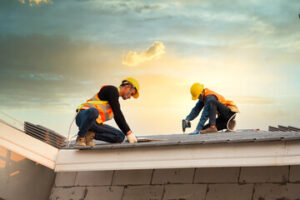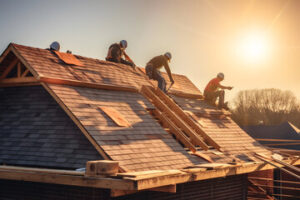A roof is one of the most important parts of a home, but it’s easy to overlook until something goes wrong. If you notice sagging or leaks in areas that previously seemed intact, consider getting your roof replaced.

Check with your homeowners insurance company to see if you can get some of the costs covered. You may be able to claim it as an emergency repair or for new construction damage. Visit https://www.jmelitecontractors.com to learn more.
Replacing a roof can be an expensive home improvement project. It is important for homeowners to understand what the costs are before starting. Some of the largest costs associated with a roof replacement are the materials and labor. The cost of a new roof depends on the type of roofing material that is chosen. Homeowners can opt for budget-friendly asphalt shingles or spend more money on luxury copper. Some other factors that affect the cost of a roof include its size, slope, and square footage.
The cost of a new roof is usually split into two parts: 40 percent materials and 60 percent labor. The material choice is one of the few elements that a homeowner can control, so it is a good idea to select a long-lasting material. It is also possible to save on the initial costs by doing a partial roof replacement instead of a full roof.
In addition to the cost of materials, homeowners should consider the costs of any associated repairs or upgrades. If a contractor finds damage to the structure or other components of the home during the roof installation, they will need to repair them before putting down the new roof. These additional expenses can add up quickly and should be included in the total roofing estimate.
Finally, homeowners may need to pay for the disposal of the old roof or other waste materials from the construction project. If a dumpster needs to be rented and disposed of on-site, these costs will need to be added to the total roofing cost.
Homeowners can choose to pay for the roof replacement with cash, a personal loan, or a credit card. It is important for homeowners to know the limits of their credit cards, as using too much of their available credit can have negative consequences. In some cases, a homeowner may be able to get a home equity loan to finance the roof replacement. This is a great option for those with high enough home equity to cover the cost of a new roof without having to refinance their mortgage.
Materials
While shingles may be the roofing material most homeowners think of when it comes to roof replacement, they aren’t the only thing that goes into your roof. The roof is a system made up of many parts that work together to keep water, heat, and cold out while allowing air to flow through. Each part has its own cost, and the type of roof materials you choose will play a big role in the overall price of your project.
When choosing a roofing material, you want to consider its lifespan and manufacturer warranty. A reputable roofing contractor will be able to help you find a material that meets your needs and budget. Some popular roofing materials include asphalt shingles, metal, and tile. Asphalt shingles are known for their durability and affordability, while metal roofs are more durable and can save you money on energy bills. Tile roofs are also energy-efficient and can last for decades.
The most important factor in determining the cost of a roof is the type of material you choose. Other factors include labor, removal and disposal of existing roofing materials, and additional upgrades like insulation or ventilation systems. You may also need to pay for permits and inspections, which will add to the final cost of your project.
It’s also important to look at the other components of your roof to determine the overall cost. For example, the roof deck is the base of your roof, and it’s typically made from plywood or oriented strand board (OSB). If you’re doing a total tear-off, this layer will need to be removed and disposed of, which will increase the cost of your project.
Other roof materials to consider include corrugated galvanised iron, which has wavy corrugations that resist lateral flexing and is fitted with exposed fasteners. It’s an economical choice for sheds and garages, but doesn’t offer the same protection as other roofing materials. Another option is EPDM membrane, which is a single-ply synthetic material that’s perfect for flat or low-slope roofs. It’s durable, affordable, and has great fire and impact-resistance.
Installation
In a full roof replacement, the contractor removes both layers of existing shingles and any underlying plywood or OSB decking that needs repair. They also replace the ventilation in your roof, which ensures that air can flow in and out of your attic, preventing a buildup of hot or cold air and helping keep your home comfortable all year round. In addition, they may replace or add new pipe boots that wrap tightly around plumbing pipes sticking out of your roof.
Once the old roof is removed, the roofing team will prep the area where they’ll be putting the new roof. They’ll cover your lawn and shrubbery with tarps to protect them from nails and debris as they work and use magnetic tools to remove any metal objects or sharp fragments from the yard. They’ll also install gutter guards if you have them, and a temporary fence if your property is in an especially windy location.
Smaller projects, like a single-family shingle roof, can be completed within a few days, weather permitting. Larger projects, such as multi-family homes or complex roofs with dormers, chimneys, skylights and more, can take weeks to complete. In these cases, the longer timeframe is usually due to permit approvals or inspections. The contractor will consult with you to discuss your home’s unique factors and help you choose a timeline that works best for your situation.
Homeowners who have equity in their homes can choose to finance a portion of their roof replacement with a home equity loan or credit card. This helps them avoid paying interest on the entire sum of money they’re borrowing, and it can help keep their monthly payments low. However, a homeowner should always check with their mortgage lender to see what they’re required to do before choosing a financing option for their home improvement project.
A homeowner may decide to replace their roof entirely, rather than just repair leaks or replace missing shingles, for a few reasons. For one, a patched roof can lower the home’s resale value by showing signs of wear and tear in multiple locations. Additionally, replacing an entire roof can reduce your overall costs and make the house look more uniform in appearance.
Warranty
While the investment of a new roof is significant, homeowners can protect this investment with a warranty. However, before you invest in a roofing warranty make sure that you read the fine print and understand what is covered. Many warranties come with limitations, exclusions, or time periods within which repairs must be completed. The longer a warranty lasts, the more expensive it will likely be. Additionally, the terms of the warranty will vary from one contractor to the next. Therefore, you should compare quotes from several different contractors to find the best deal.
The two primary types of roof warranties are material warranties and workmanship warranties. A material warranty is provided by the manufacturer of the roofing materials and covers defects in those materials. These warranties range from 10 to 50 years. A workmanship warranty is offered by the roofing contractor and covers installation errors. These warranties may last for a shorter period of time, depending on the contractor.
Many manufacturers also offer extended warranty plans for their products. These extended warranties often include the cost of a complete replacement of a roof, including labor and materials, in case of a major structural issue. However, these enhanced warranty plans typically come with a higher price tag and require that you work with a certified contractor and follow other guidelines in order to qualify for coverage.
In addition, the type of roofing you select will have an impact on your warranty coverage. Asphalt shingles are the most common roofing material, offering affordability and versatility. Metal roofing is an increasingly popular option, offering durability and energy efficiency. Other options include tile or slate, which provide a classic and natural look, but can be costly and require more maintenance.
Regardless of the type of roofing you choose, it is important to keep in mind that regular inspections and routine maintenance will help extend the life of your roof and may be eligible for warranty coverage. Also, it is important to note that certain activities can void your warranty, such as hiring a non-certified contractor for repair work or neglecting to perform maintenance and inspections.


